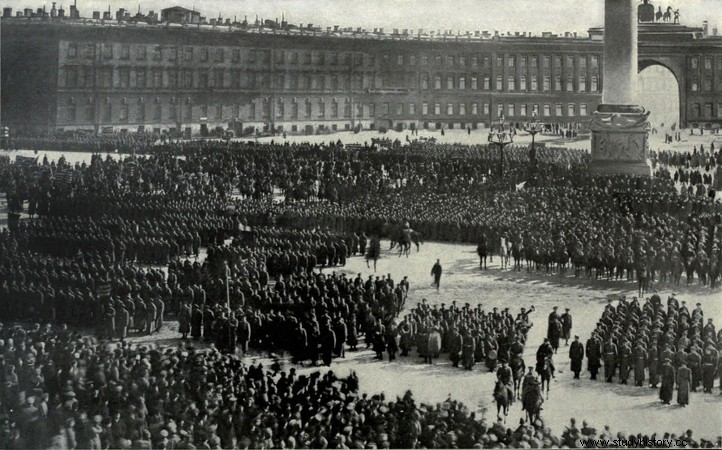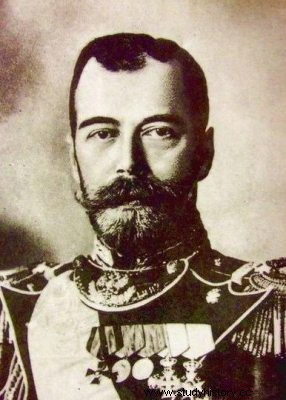
The history of the 20th century had in the Revolution Russian of 1917 one of its main events. The construction of the Soviet state by members of the Bolshevik party resulted in a change in the forms of economic development seen up to that moment. 
The modernization of Russian society occurred differently from Western European capitalists. Instead of the constitution of an industrialized society based on the action of the bourgeoisie and supported by the private ownership of the means of production, what happened was a process of industrialization and social modernization whose center was the State.
The Soviet state became the owner of the means of production. This centrality of ownership provided state controllers, Bolshevik party bureaucrats, and business managers with a capacity for economic and social planning the breadth of which had not been experienced anywhere else.
But to understand this result of the Russian Revolution, it is first necessary to follow the paths of the revolutionary process.
Background
The process of modernization of Russian society gained strong momentum in the second half of the 19th century. Some measures adopted by the tsars of the Romanov dynasty contributed to this modernization.
In 1861, there was the Emancipation of the Servants. The end of serfdom had as one of its consequences a greater freedom of production and commercialization on the part of the peasants. This consequence resulted, on the other hand, in the internal division of the peasantry over the following decades, with the stratification between rich, middle and poor peasants. However, a large amount of land still belonged to the nobility. In 1917, such a situation would provide one of the main demands of the Revolution:the distribution of land.
Another component of the modernization carried out in the 19th century was linked to the stimulus to industrialization. A large amount of foreign and Russian capital, to a lesser extent, was invested in building industries in some western regions of Russia. In these places, like St. Petersburg and Moscow, a large working class originated from the peasantry was formed. The concentration of workers in these industries surpassed that existing in the more developed economies of Western Europe.
These social and economic changes created contradictions with the authoritarian structure of the tsarist autocracy. The Russo-Japanese War of 1905 was the trigger for what is conventionally called the revolutionary essay of 1917.
The disastrous consequences of the war were felt mainly by the peasants, who supplied the soldiers for the Russian army. Death in the war, hunger and the cold of that year led part of the population of Saint Petersburg to ask the Tsar for measures to solve their difficulties. This event took place on a Sunday, January 22, 1905. The crowd heading to the Winter Palace in St. Petersburg was met with gunfire by the tsar's troops. Thus began the Revolution of 1905.
The main feature of this revolution was the creation of a council of delegates of workers in St. Petersburg. This form of self-organization of the Russian workers became known in history as the Soviet , which in Russian means advice .
At the same time, some political parties were forming. It is important to highlight the parties that developed together with the exploited classes, such as the Socialist-Revolutionaries, linked to the peasants, and the Russian Social Democratic Labor Party (RSDLP), which was divided into two main fractions, the Mensheviks and the Bolsheviks.
In early 1906, the Tsar managed to contain the revolutionary process. He created a parliament, called the Duma, pointing to the beginnings of political freedom along the lines of a constitutional monarchy. But during the years 1906 and 1917, this political freedom did not materialize in practice.
February 1917
The Russian Empire was one of the main stakeholders in the First World War, which started in 1914. But the Russian army was no match for the German military forces. One of the results was the mass desertion of front-line soldiers. Another was the intensification of hunger among the population that remained in Russian territory.
In the final days of February 1917, a demonstration for International Women's Day in Saint Petersburg turned into a demonstration against hunger experienced by a large part of the population. The demonstration won the support of soldiers dissatisfied with the war. Dissatisfaction grew and the demonstrations gained strength.
On February 27, soldiers and workers stormed the Tauride Palace, achieving the tsar's resignation and the formation of a Provisional Government. At the same time, the workers and soldiers constituted the soviets again.
This situation became known as double power , with the bourgeoisie and aristocracy organizing in the Duma, and the workers, soldiers and peasants organizing in the soviets.
The main demand of the population was an end to the war and measures to alleviate hunger, in addition to the distribution of land.

Lenin, leader of the Bolshevik Party
Credit:Iryna1 and Shutterstock.com
After March 1917, a number of employers began to abandon their factories. The workers, in order not to lose their jobs, began to occupy the premises of the companies and to organize committees of workers responsible for the control of production.
Social conflicts were intensifying. A process of political opening began. In April, one of the main Bolshevik leaders, Lenin, returned from exile. From that moment on, he managed to influence more intensely the direction to be taken by the Bolshevik party.
In July, military forces linked to tsarism tried to overthrow the Provisional Government, being impeded mainly by the organized workers and peasants. Realizing the intensification of the situation of social conflict, the Bolsheviks launched the motto Bread, Peace and Land in order to garner popular support.
In October 1917, with the arrival of winter, sectors of the Bolsheviks saw the need to take a more radical measure, the seizure of power. Peasants were already occupying the lands of the aristocracy and the church, the workers intensified the formation of soviets and factory committees.
October 1917
By September, the Bolsheviks had gained control of the St. Petersburg Soviet. On the eve of the Second All-Russian Congress of Soviets, the Bolsheviks decided to overthrow the Provisional Government. On October 25, 1917, the Smolni Institute was invaded by the Red Guard.
Basing their power on the soviets and allies with the left wing of the Socialist-Revolutionary Party, the Bolsheviks initiated measures for the construction of the Soviet State. The holding of the Constituent Assembly was interrupted. Workers' control of production was established. The lands of the nobility and the church were divided between the peasantry. To administer the state, the Congress of Soviets created the Council of People's Commissars.
Between October 1917 and March 1918, the Bolsheviks laid the foundations of the new state. The administration of the economy was centralized in state institutions that began to outline production planning, seeking to maintain workers' control of companies within certain limits. The Red Guard was replaced by the Red Army, commanded by Trotsky. The Brest-Litovsk Peace Treaty was signed with Germany, pulling Russia out of World War I.
Civil War
Shortly after the signing of the peace treaty, a Civil War began in Russia, which lasted from 1918 to 1921. The forces linked to the former tsarist regime gathered in the White Army . They also got support from Western capitalist powers to try to overthrow the nascent Soviet power.

Leon Trotsky at the head of Red Army troops
Credit:University of Toronto Library
Soviet organization in the Civil War created the basis for state centralization of the economy and control of social life. The constitution of War Communism sought to administer the new state. Based on the militarization of the economy, directing it towards Civil War efforts, War Communism imposed military discipline on industries and also began to confiscate peasant crops.
In Ukraine, which had become independent, peasants and workers organized around the guerrilla group led by Nestor Makhno. Makhnovchina was an important organization in the fight against the White Army and also in the organization of production, mainly agricultural, in Ukraine.
The action of the Makhnovtchina and the Red Army managed to contain the invasion of the White Army. But by the end of the Civil War, Russia was ravaged by famine and the destruction caused by the war. However, the militarization promoted by the Bolsheviks remained, mainly in the centralizing role of the State.
Makhno's forces were destroyed shortly after the civil war. A rebellion against the new state, held in the Kronstadt fortress, was massacred by the Bolsheviks. The sailors of this fortress, who were the main revolutionary force in Russia, called for the election of free soviets, thus seeking to diminish Bolshevik power.
Even the temporary economic freedom provided by the New Economic Policy (NEP) did not shake the centralizing structures of the Soviet State. The period of centralization of economic, political and social control of the Civil War shaped the form of organization of the USSR, mainly from 1928, when the lands were nationalized and the first Five Year Plan was inaugurated. With this plan, party bureaucrats and company administrators were able to start planning the Soviet economy, boosting the industrialization of the USSR.
Take the opportunity to check out our video lesson on the subject:
